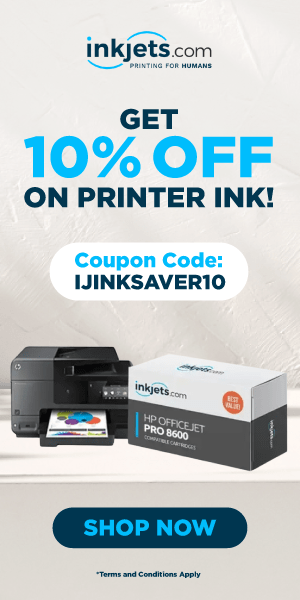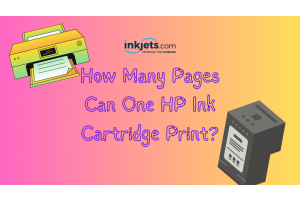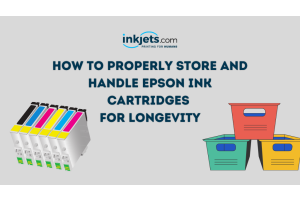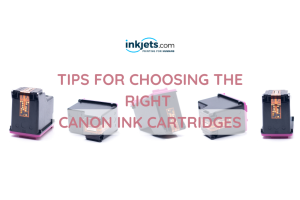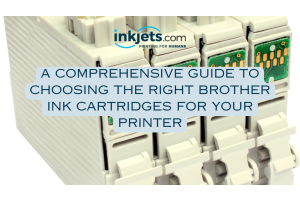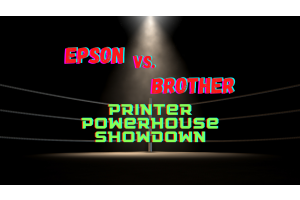
In the world of printing, where clarity meets color, the importance of selecting the right ink cartridges for Canon printers cannot be overstated. It's not just about replenishing ink; it's about making a choice that affects every document, photograph, and piece of art you print. Choosing the right Canon ink cartridges is pivotal for ensuring your prints come out vibrant, clear, and true to your vision.
The benefits of making the right choice extend far beyond just print quality. It's about the longevity of your printer, the consistency of your prints, and, importantly, the impact on your wallet. Opting for the correct ink cartridges can lead to significant cost savings over time, especially when you consider the potential for reduced ink consumption and fewer cartridge replacements. Moreover, the right ink ensures that your printer remains in optimal condition, reducing the likelihood of clogs or damage caused by incompatible cartridges.
Join us as we navigate through the essentials of choosing the right cartridges for Canon printers, making your printing experience not just a task, but a journey to achieving perfect prints every time.
Understanding Printer Compatibility


The foundation of achieving exceptional print quality begins with understanding the relationship between your printer and its ink cartridges. Printer model compatibility is paramount, as not all cartridges are created equal, and using the wrong type can lead to poor print quality, damage to your printer, or even void your printer's warranty.
For Canon printer owners, knowing how to match your printer with the right ink cartridges is the first step toward unlocking the full potential of your printing capabilities.
Tips on Finding and Verifying Compatible Cartridges
1. Check Your Printer’s Model Number: The simplest way to start is by knowing your Canon printer's exact model number. This can usually be found on the printer itself, often on a label on the back, bottom, or inside the printer door.
2. Refer to the Printer Manual or Manufacturer’s Website: Canon's official website or the printer's manual is an excellent resource for finding compatible ink cartridges. Most manufacturers provide a list of compatible models for each cartridge.
3. Use the Cartridge Finder Feature: Many online retailers and official websites have a cartridge finder tool. By entering your printer’s model number, these tools can quickly provide you with a list of compatible cartridges.
4. Look for the Cartridge Number: If you have an existing cartridge, sometimes the easiest way is to look for the cartridge number on it. You can then search for this number to find replacements.
5. Compatibility Lists on Packaging: When shopping for ink cartridges, check the packaging for a list of compatible printer models. Most manufacturers, including Canon, clearly list which printer models are compatible with that specific ink cartridge.
6. Customer Support: When in doubt, Canon’s customer support can be an invaluable resource. They can confirm cartridge compatibility and may offer recommendations based on your specific printing needs.
By ensuring that you select cartridges that are fully compatible with your Canon printer, you not only safeguard your printer’s health but also guarantee that each print will be as beautiful as the last. Compatibility is the key to unlocking the door to efficient, high-quality printing that stands the test of time.
Original vs. Compatible vs. Remanufactured Cartridges


When it comes to choosing ink cartridges for your Canon printer, you're faced with three primary options: original (OEM), compatible (third-party), and remanufactured cartridges. Understanding the differences between these options is crucial for making an informed decision that meets your printing needs and preferences.
Read: Everything You Need to Know About Remanufactured Ink Cartridges
Original (OEM) Cartridges
Definition: Original Equipment Manufacturer (OEM) cartridges are produced by the same brand that made your printer. For Canon printers, these are cartridges made by Canon itself.
Pros:
Guaranteed Compatibility: Designed specifically for Canon printers, ensuring a perfect fit and functionality.
High-Quality Prints: Delivers optimal print quality and performance as it's formulated to work seamlessly with your printer.
Reliability: Less likely to cause damage or warranty issues with your printer.
Cons:
Cost: Generally, this is the most expensive option compared to compatible and remanufactured cartridges.
Environmental Impact: Producing new cartridges requires more resources and contributes to environmental waste if not recycled properly.
Compatible (Third-Party) Cartridges
Definition: Compatible cartridges are produced by third-party manufacturers and designed to work with specific printer models without infringing on the printer manufacturer's patents.
Pros:
Cost-Effective: Typically more affordable than OEM cartridges.
Wide Availability: Easy to find online or in stores.
Innovative Designs: Some may offer more ink capacity than OEM cartridges.
Cons:
Variable Quality: The quality can vary significantly between manufacturers.
Compatibility Issues: May not fit as perfectly as OEM cartridges, potentially leading to leaks or recognition issues.
Warranty Concerns: Using third-party cartridges might void your printer's warranty in some cases.
Remanufactured Cartridges
Definition: Remanufactured cartridges are used OEM cartridges that have been cleaned, repaired, refilled with ink, and tested to ensure they meet quality standards.
Pros:
Eco-Friendly: Reduces waste by reusing existing cartridges.
Cost Savings: Usually cheaper than both OEM and compatible cartridges.
Quality Assurance: Undergo testing to ensure they meet certain standards.
Cons:
Inconsistent Quality: While many are reliable, the quality can still vary.
Printer Compatibility: Occasionally, remanufactured cartridges might not be recognized by your printer due to chips or firmware updates.
Evaluating Ink Quality


The quality of ink in your cartridges directly influences the outcome of your prints. High-quality ink ensures vibrant colors, sharp details, and longevity of your printed documents and photos.
Tips for Ensuring High-Quality Ink
Research Brands: Look for reputable brands that have positive reviews from consumers and experts alike. Whether you're considering OEM, compatible, or remanufactured cartridges, brand reputation can be a strong indicator of quality.
Check for Certifications: Some cartridges are certified by third parties for meeting specific quality and environmental standards. Look for these certifications as a sign of reliability.
Test Prints: If possible, perform test prints to evaluate the color accuracy, sharpness, and overall quality of the ink. This can be particularly useful when trying out a new brand or type of cartridge.
Return Policies: Purchase from retailers or brands that offer a satisfaction guarantee or return policy. This gives you recourse if the ink quality does not meet your expectations.
While cost and environmental impact are important considerations, the quality of your prints should not be compromised. By carefully selecting your ink cartridges and considering the source of the ink, you can ensure that your Canon printer continues to produce exceptional prints for all your needs.
Cost Considerations


Navigating the cost of ink cartridges is crucial for both individual users and businesses alike. The initial price of a cartridge is just one aspect of its overall cost-effectiveness. Understanding the differences in cost between original (OEM), compatible (third-party), and remanufactured cartridges, along with their long-term implications, can help you make a more informed decision that balances quality with expense.
Cost Differences and Long-term Implications
Original (OEM) Cartridges: While these cartridges offer the highest quality and reliability, they also come with a premium price tag. However, investing in OEM cartridges can mean fewer print issues and potentially lower long-term costs related to printer maintenance and wasted materials due to print errors.
Compatible (Third-Party) Cartridges: These are often the go-to option for cost-conscious consumers. They can be significantly cheaper than OEM cartridges but come with the risk of variable print quality and possible compatibility issues, which could lead to increased costs over time if they damage your printer.
Remanufactured Cartridges: These strike a balance between cost and eco-friendliness. They are cheaper than OEM cartridges and have a lower environmental impact. However, their quality and printer compatibility can be hit-or-miss, which might result in additional costs for replacements or repairs.
Tips for Finding Cost-Effective Solutions
Bulk Purchasing: Buying cartridges in bulk or as part of a multi-pack can offer substantial savings over purchasing them individually. This approach is particularly effective for businesses or individuals with consistent print needs.
Subscription Services: Some manufacturers and third-party providers offer ink subscription services that can lower the cost per cartridge. These services typically ensure that you receive a new cartridge before your current one runs out, helping to manage costs and avoid the inconvenience of last-minute purchases.
Loyalty Programs: Participating in loyalty programs offered by retailers or manufacturers can lead to discounts, coupons, or points that can be redeemed for future purchases. This can effectively lower the overall cost of ink cartridges over time.
Opt for High-Yield Cartridges: If available for your printer model, high-yield or XL cartridges contain more ink and can print more pages than standard cartridges, offering a lower cost per page despite a higher initial price.
Consider Print Settings: Utilize your printer’s economy or draft print settings for everyday printing needs. This uses less ink and can significantly extend the life of your cartridges, saving money in the long run.
By taking a strategic approach to purchasing ink cartridges, you can find cost-effective solutions that do not compromise on the quality of your prints. Whether through smart purchasing options like bulk buying and subscriptions or by optimizing your printer settings, there are numerous ways to manage printing costs while still achieving high-quality results.
Ink Longevity and Page Yield


Ink longevity and page yield are key factors that significantly influence the overall value and efficiency of your printing operations. Understanding these concepts can help you choose ink cartridges that not only fit your printing needs but also offer the best value over time.
Ink Longevity
Ink longevity refers to the shelf life of the ink in a cartridge and its ability to maintain quality over time. This is crucial for users who print infrequently, as ink can dry out or degrade if a printer is not used regularly. High-quality ink formulated for longevity can resist drying and ensure that cartridges remain ready to print, even after periods of inactivity.
Page Yield
Page yield is the estimated number of pages a single ink cartridge can produce before running out of ink. It's a vital metric for understanding the cost per page, allowing consumers to compare the value of different cartridges beyond just their upfront cost.
Manufacturers typically provide page yield estimates based on standardized industry tests, which involve printing a specific document repeatedly until the cartridge runs out of ink.
Why They Matter
Together, ink longevity and page yield are critical for evaluating the true cost and value of ink cartridges. A cartridge with a high page yield and long ink longevity can offer greater value by providing more prints over a longer period, reducing the frequency of cartridge replacements and ensuring consistent print quality.
Choosing Cartridges for Best Value
Look for High-Yield Options: High-yield or XL cartridges are designed to print more pages than standard cartridges, offering a lower cost per page. They are ideal for high-volume printing needs.
Consider Third-Party Reviews: Independent reviews and consumer feedback can provide real-world insights into the performance and value of different ink cartridges, including their actual page yields and ink longevity.
Check Manufacturer's Page Yield Estimates: Manufacturers provide page yield estimates based on standard tests. Compare these figures across different cartridges to gauge which offers the best value for your typical printing volume.
Evaluate Your Printing Needs: Assess how often you print and what you print. If you print frequently, a high-yield cartridge may be more cost-effective. If you print infrequently, consider the longevity of the ink to avoid the cost of replacing dried-out cartridges.
Quality Matters: A slightly more expensive cartridge that offers higher quality ink and more reliable page yields can be more cost-effective in the long run, as it can reduce the need for reprinting and waste.
By prioritizing ink longevity and page yield when selecting cartridges, you can ensure that you choose an option that provides the best balance of cost, quality, and efficiency for your Canon printer. This approach can help minimize overall printing costs while maintaining high-quality outputs for all your printing needs.
Read: Benefits and Cost Savings of Canon's High-Yield Ink Cartridges
Environmental Considerations and Recycling Options


The environmental impact of ink cartridges is significant, with millions of used cartridges ending up in landfills each year, where they can take up to 1,000 years to decompose. The manufacturing process also consumes resources and energy, contributing to carbon emissions. However, making eco-friendly choices when selecting and disposing of ink cartridges can mitigate these impacts and contribute to a more sustainable future.
Importance of Eco-Friendly Choices
Choosing eco-friendly ink cartridges and participating in recycling programs are steps that can significantly reduce the environmental footprint of your printing activities. By opting for cartridges that are designed with sustainability in mind, such as those made from recycled materials or those that can be easily recycled, you help conserve natural resources and reduce waste. Additionally, supporting companies and products that prioritize environmental sustainability encourages the industry to adopt greener practices.
Recycling Programs
Many manufacturers, including Canon, offer recycling programs for their ink cartridges. These programs often provide a free and convenient way for consumers to send back used cartridges for recycling or proper disposal, preventing them from ending up in landfills.
Manufacturer Take-Back Programs: Check if the manufacturer of your ink cartridges offers a take-back or recycling program. These programs are often advertised on the product packaging or the manufacturer’s website.
Retailer Recycling Initiatives: Some office supply stores and retailers have drop-off points for used ink cartridges, sometimes offering discounts or store credits as an incentive for recycling.
Municipal Recycling Programs: Local waste management or recycling centers may accept ink cartridges as part of their recycling programs. Contact your local facilities to find out their policies.
Eco-Friendly Cartridge Options
Remanufactured Cartridges: These cartridges are cleaned, refilled, and tested for quality, significantly reducing waste and the consumption of raw materials compared to new cartridges.
Refillable Cartridges: Some printers are compatible with refillable ink cartridges, which can be manually refilled with ink bottles, drastically cutting down on plastic waste.
Cartridges Made from Recycled Materials: Look for cartridges that are made using recycled plastics or other materials, as these reduce the need for new raw materials and help close the loop in the product lifecycle.
How to Participate in or Find Recycling Programs
Research: Visit the websites of your ink cartridge manufacturer or local recycling centers to learn about available recycling options and how to participate.
Inquire at Purchase: When buying ink cartridges, ask the retailer about recycling programs or eco-friendly cartridge options they may offer or recommend.
Educate and Encourage: Share information about recycling programs and the importance of eco-friendly printing practices with friends, family, and colleagues to increase awareness and participation.
Making environmentally responsible choices in how you purchase, use, and dispose of ink cartridges can have a positive impact on the planet. By opting for eco-friendly options and participating in recycling programs, you contribute to reducing waste, conserving resources, and promoting sustainability in printing practices.
Read: How to Recycle Ink Cartridges
Where to Buy


Purchasing ink cartridges for your Canon printer involves more considerations than just price alone. Factors such as authenticity, warranty, and customer support are essential to ensure you're making a purchase that won't negatively affect your printer's performance or your satisfaction. Here's how to navigate the purchase process, keeping these important factors in mind.
Authenticity
Authorized Retailers and Official Websites: Buying from authorized retailers or directly from the printer manufacturer’s official website guarantees that you’re getting genuine cartridges. Authentic cartridges ensure optimal compatibility and performance, protecting your printer from potential damage caused by counterfeit products.
Warranty and Support
Check for Warranty: Ensure the cartridges you purchase come with a warranty. This protects you in case of defects or compatibility issues. A good warranty indicates the seller's confidence in their product's quality.
Customer Support: Consider retailers or suppliers that offer robust customer support, including easy returns, troubleshooting help, and assistance with compatibility issues. Good customer support can significantly enhance your purchasing experience, especially if you encounter any issues with your ink cartridges.
Where to Shop
Inkjets.com for Canon Ink Cartridges: When looking for affordable yet high-quality Canon ink cartridges, Inkjets.com is a viable option to consider. They specialize in providing a wide range of ink cartridges, including OEM, compatible, and remanufactured options, catering to various needs and budgets.
Advantages of Inkjets.com:
Affordability: Offers competitive pricing on Canon ink cartridges without compromising on quality.
Quality Assurance: Provides high-quality cartridges that meet or exceed OEM specifications.
Customer Support: Offers excellent customer service, including easy returns and support for any queries or issues.
Wide Selection: Whether you need standard, high-yield, or specialty cartridges, you’re likely to find what you're looking for.
Online Marketplaces and Specialty Stores: Besides Inkjets.com, you can explore other reputable online marketplaces and specialty stores. Be vigilant about seller ratings and customer reviews to gauge reliability and product quality.
Local Office Supply Stores: For immediate needs, local office supply stores often stock a variety of ink cartridges and can offer the advantage of in-person support and advice.
When purchasing ink cartridges, balancing cost with quality, warranty, and support ensures you get the best value and performance from your Canon printer. Websites like Inkjets.com offer a promising route for finding affordable, high-quality options, but always remember to conduct thorough research and consider your specific printing needs before making a purchase.
Trobleshooting and Common Issues


Even with careful selection, you might occasionally encounter issues with ink cartridges, particularly if they're incompatible or of low quality. Common problems include printer errors, recognition issues, or subpar print quality. Fortunately, there are steps you can take to troubleshoot or prevent these issues from arising.
Common Issues and Solutions
Printer Errors or Non-Recognition: Sometimes, a printer may not recognize a newly installed cartridge. This can be due to chips on cartridges not communicating correctly with the printer or physical mismatches.
Solution: Try removing and carefully reinstalling the cartridge, ensuring it's properly seated. If the issue persists, reset the printer or check for firmware updates that might resolve compatibility issues.
Poor Print Quality: Low-quality prints, such as those with streaks, faded areas, or incorrect colors, can often result from low-quality ink or clogged print heads.
Solution: Run the printer's cleaning cycle to clear clogged nozzles. If quality issues continue, try using a different brand or source of ink cartridges that are known for higher quality. Always ensure the ink hasn't expired, as old ink can lead to poor print results.
Tips for Troubleshooting or Preventing Issues
Use High-Quality Cartridges: Investing in high-quality or OEM cartridges can significantly reduce the likelihood of issues.
Regular Printer Maintenance: Perform regular printer maintenance, including using the printer's built-in cleaning and alignment functions. This can prevent many quality issues before they start.
Firmware Updates: Be cautious with firmware updates from your printer manufacturer, as some updates may prevent non-OEM cartridges from being recognized. However, updates can also solve recognition issues for compatible cartridges, so it's a balance.
Store Cartridges Properly: Ensure unused cartridges are stored in a cool, dry place and in their original packaging to prevent them from drying out or getting damaged.
Contact Customer Support: If you're experiencing persistent issues, don't hesitate to reach out to the cartridge supplier's customer support. They can often provide troubleshooting tips or replacements if the product is faulty.
By being proactive and informed about your printer and ink cartridges, you can mitigate most common issues, ensuring smooth printing operations and maintaining the quality of your prints.
Read: Canon Printer Troubleshooting Tips
Compatible Ink Cartridges For Your Canon Printer


Here are some cartridges that are compatible with popular Canon inkjet printers:
Canon PG-240XXL
Compatible with: PIXMA TS5120, PIXMA MX372, and PIXMA MG2120
Page Yield: 600 pages
Compatible with: PIXMA MG3500, PIXMA MX432, PIXMA MX439, and PIXMA MX532
Page Yield: 400 pages
Compatible with: PIXMA MP280, MP495, MX320 and iP2702
Page Yield: 400 pages
Compatible with: PIXMA MP270, PIXMA MP499, PIXMA MX350 and PIXMA IP2700
Page Yield: 349 pages
Compatible with: PIXMA PRO 100
Page Yield: 1,000 pages
Conclusion
Navigating the world of Canon ink cartridges involves more than just picking the first option that fits your printer. Throughout this article, we've explored the critical factors that impact your printing experience, from understanding printer compatibility to making eco-friendly choices. We've emphasized the importance of selecting the right type of cartridge—be it OEM, compatible, or remanufactured—while also considering cost implications, ink quality, and environmental impact.
Key points to remember include:
Printer Compatibility: Ensuring cartridges are compatible with your printer model is fundamental to avoid any functionality issues.
Cartridge Types: Weigh the pros and cons of OEM, compatible, and remanufactured cartridges to find the best balance of quality, cost, and environmental sustainability.
Ink Quality and Longevity: High-quality ink contributes significantly to superior print results and can help prevent common printing issues.
Cost-Effectiveness: Look for value beyond just the purchase price, considering page yield and long-term implications on printer maintenance.
Environmental Responsibility: Opt for eco-friendly practices, like using remanufactured cartridges and participating in recycling programs, to minimize your environmental footprint.
Troubleshooting Tips: Addressing common issues promptly and effectively can help maintain your printer’s performance and extend the lifespan of your cartridges.
Choosing the right Canon ink cartridges with these considerations in mind will not only enhance your printing results but also ensure a smoother, more cost-effective, and environmentally friendly printing process.
Take your time to research, compare, and select the cartridges that best meet your specific needs and preferences. By making a thoughtful selection, you'll enjoy the benefits of consistent, high-quality prints and a more satisfying overall printing experience.
Remember, the effort you put into choosing the right ink cartridges pays off in the long run, both for your prints and your printer.


